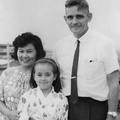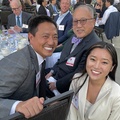Shinzo Abe, the former prime minister of Japan, was assassinated on July 8, 2022.
Almost immediately after the news broke, hundreds of global news outlets published articles praising his leadership during his eight-year term—the longest uninterrupted run as a Japanese leader—as I, a Shin-Nisei, sat in shock at the news of his death.
Abe souri (so-uu-ri, meaning prime minister) was the only politician I had ever known to lead Japan. He became the face of Japan when I was nine years old and continued to serve until I was seventeen. When I watched Japanese news with my parents as a child, his face would be plastered across the screen. When I became interested in pursuing a career in US-Japan relations, his name would appear in nearly every article I read.
Of course, I had never met Abe souri, nor was I a super-fan of his. So why did I—a JA girl who grew up 5,313 miles away from his politics—feel so much anger and disappointment over his death?
It took me a few days to realize the source of my emotions—not only the fact that he was assassinated but how he was. Abe souri was assassinated in public by a gun; as some Twitter users liked to call it, “public execution style.”
There is little to no gun violence in Japan.
In 2018, Japan only reported nine deaths from firearms, compared to the 39,740 deaths that year in the United States.1 Japan’s gun laws only permit the sale of shotguns and air rifles—other than the police and the military, no one in Japan may purchase a handgun or a rifle. Even if a person wanted to acquire a firearm, they would have to attend an all-day class, pass a written exam and a shooting range test with an accuracy of at least 95%, undergo a mental health evaluation and drug tests, as well as a rigorous background check—all just to acquire their license. So how was the assassin able to obtain a firearm?
The simple answer: he couldn’t. The assassin couldn’t obtain a firearm due to the strict regulation laws, so he went to the next best possible solution—to make his gun.
Tetsuya Yamagami, the assassin, was an ex-member of Japan’s navy. His naval background allowed him to have a deeper understanding of handling and assembling weapons. Furthermore, crime experts say the internet had a major role in helping Yamaguchi assemble the weapon. There are thousands of “how to” videos out there, and it seems Yamaguchi utilized those videos to create his weapon of choice.
The extent to which Yamaguchi went to assassinate Shinzo Abe appalled me. He spent countless hours creating the perfect plan and welding the most effective weapon to murder one man with who he had a grudge.
What would happen if an individual held a grudge against a group of people? Perhaps a resentment towards students or a racial group?
Mass shootings would erupt everywhere—in schools, in temples, in communities.
I was in second grade when I first experienced the fear of a school shooting. Our school received an alert from our neighboring high school that an active shooter was on their campus; their security guard was shot in the leg. I was only seven years old, but I vividly remember locking the door, closing the blinds, and setting up an emergency bathroom in the corner of my classroom. I remember my classmates quietly crying and my teacher trying to comfort us all in her state of fear. We locked ourselves in our classroom for hours until we received notice that the shooter didn’t actually exist: the security guard had purposely shot himself in the leg and lied that there was a shooter because he wanted to be praised as a “hero.”
I was in eighth grade when I saw a gun threat with my own eyes. Somebody had scribbled the words “I hate this school. Shooting it up this Friday,” followed by the date, onto the girls’ bathroom wall. The message was reported, and my school shut down that day.
I was a senior in high school when I first heard about a group of people who were mass murdered for being Asian American. I remember a chill going down my spine when I knew that could have been me, my family, or my friends—murdered just for being Asian American.
Gun violence has been so prevalent in my life that I became desensitized to it. The media continuously reports mass shootings after mass shootings; the next shooting occurring before the details are reported about the prior one. The United States leads globally in the number of mass shootings per year. In developed countries, we outnumber the gun violence deaths per 100,000 people by 631% compared to Cyprus, which ranks second.2
As a Shin-Nisei who takes pride in the peacefulness of Japanese culture, I never wanted Japan to be tainted by the fear of gun violence. I never wanted the children and citizens of Japan to have to consider the possibilities of mass shootings in their daily lives. Children should not fear going to school. Parents should not have to worry when they drop their kids off at school, distressed that it may be the last time they see them. Elders should not have to refrain from attending temple out of the fear that their life will be ended by a bullet. But the former prime minister’s death proved gun violence can occur in Japan.
Shinzo Abe’s assassination changed Japan’s gun culture forever.
Notes:
1. According to the Sydney School of Public Health, University of Sydney.
2. “Gun Violence in the US Far Exceeds Levels in Other Rich Nations,” Bloomberg. May 26, 2022.
*This is one of the projects completed by The Nikkei Community Internship (NCI) Program intern each summer, which the Japanese American Bar Association and the Japanese American National Museum have co-hosted.
© 2022 Lana Kobayashi






